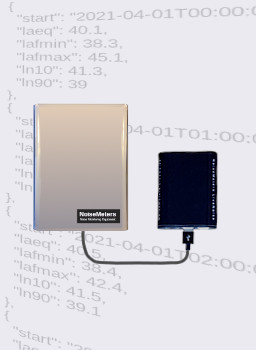
The delivery price is calculated during checkout based on your location and the goods ordered. Our basic delivery prices are:
Delivery within Canada: $53.00
Delivery Service: Five working days*
* For products that are in stock and the order received by midday.
Some products go through a final configuration and calibration before being shipped. If the calibration labs are busy this can add up to two days on to the delivery schedule but guarantees a fresh calibration.
The NMAPI-320 is part of the NoiseAPI range of noise monitors with an Application Programming Interface, or API. It consists of a Noise Processor (on the left of the image above) and a NoiseAPI Interface (black box on the right of the image), connected by a USB cable. A power supply is included to power both the Noise Processor and the NoiseAPI box.
While the Noise Processor carries out all the measurement and analysis of the sound levels, the NoiseAPI takes that information, stores it and makes it available to your application via a well defined and documented API.
The NoiseAPI responds to HTTP or HTTPS requests, either sent directly to it over your local network or through our optional routing server. There is also a WebSocket interface that you can use if you want a live feed of the sound levels or noise event notifications.
The NoiseAPI device needs power - a power adapter is included - and a network connection. It connects to your local network with a CAT5 Ethernet cable or by WiFi. Your software can now communicate with the NoiseAPI on your local network using HTTP requests.
Full API documentation, along with code samples and live examples are available through an account on our NoiseAPI server. Using an evaluation account, you can also communicate with a NoiseAPI device via our routing server. This is useful to ensure your code can communicate with it successfully and to check that the results are exactly what you need.
Please email NoiseMeters with a few details about your application and requirements. We will email back with login details for an evaluation account that you can use to see if NoiseAPI is the right solution for your application.
Most commands are available as HTTP or HTTPS GET requests. The noise measurements available are:
Time History Noise Profile
Periodic Noise Measurements
Noise Events
All responses to commands and downloads are formatted as JSON.
For example, a request for 10 seconds of time history measurements would give:
{
"cmd": "timehistory",
"status": "ok",
"from": "2021-02-16T06:00:00.000Z",
"to": "2021-02-16T06:00:09.000Z",
"laeq": [43,43,43.1,43.1,43.1,43.1,42.9,42.9,43,42.9]
}
If you want a live feed of sound levels or alerts when noise events occur you can use a WebSocket connection to the NoiseAPI device. You can mix HTTP and WebSocket connections on the same NoiseAPI device.
Full documentation, code samples and connections to NoiseAPI devices are available from your account on noiseapi.com. Please contact us for a free evaluation account.
The NoiseAPI device connects to your network using a Ethernet cable (Cat 5e, RJ45) or WiFi. While the NoiseAPI benefits from connection to the Internet (clock sync and access via our routing server), it can be used in a totally isolated setup.

This version of the NoiseAPI is for indoor use only. For use outdoor or in dusty environments we recommend the NMAPI-SE NoiseAPI, which comes in a weatherproof enclosure.
For a standard installation you will be able to access the NoiseAPI from other computers on your network. With some routing in place you could access it from anywhere on the Internet. In this case you do not need the Routing Server option.
Rather than getting involved in network routing you can make use of our Routing Server. In this case the NoiseAPI device connects to our server and you send your API requests to noiseapi.com instead of directly, so you can communicate from anywhere in the world.
There is an annual charge for use of the routing server.

The Noise Processor is mounted to a wall using the mounting plate and four screws. The NoiseAPI unit is mounted close by on just two screws.
An optional security bracket is available for the NoiseAPI box.
A standard USB cable (included) connects the NoiseAPI unit to the Noise Processor.
The system requires 5V DC, which is provided by the power adapter that is included.


| Acoustic Standards | IEC 61672-2:2002 Class 2 |
| ANSI S1.4 Type 2 | |
| Frequency Range | 20 Hz to 20 kHz |
| Measuring Range | 30 to 120 dB |
| Deviation | ± 0.5 dB |
| Frequency Weighting | "A" |
| Time Weighting | Fast, Slow |
| Measurements | LAeq, LAFmin, LAFmax, LASmin, LASmax, Ln (L10, L90, etc) |
| over user definable periods. | |
| Time history noise profile: sound level parameters every second. | |
| Additional Outputs | 0-10 V or 4-20 mA |
| USB Port | For USB memory stick configuration |
| Ethernet Port | RJ45 socket |
| Internal Memory | 16 GB for up to 5 years storage |
| Dimensions | |
| Noise Processor | 121 x 149 x 42 mm, 4.8" x 5.9" x 1.7" |
| NoiseAPI Terminal | 70 x 88 x 29 mm, 2.8" x 3.5" x 1.2" |
| Power | 5 VDC, max 12W (power adapter included) |

